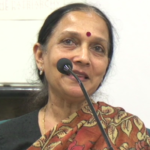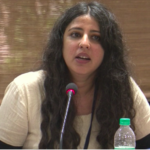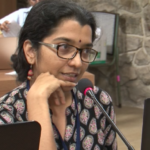Session 5. Legal ambiguities, cultural dilemmas: Walking the long road to justice for gender-based cyber violence (Talk show format)
Part 1. Interrogating the space – what makes the digital different?
Part 2. Investigating the adequacy of existing legal-institutional responses – how can the law create a supportive environment for assertions of feminist agency online?
Part 3. Access to justice – under what conditions can redress mechanisms lead to access to justice?
Speakers
Vidya Reddy, Tulir Center for the Prevention and Healing of Child Sexual Abuse, Chennai
Geeta Ramaseshan, Advocate, Madras High Court, Chennai
Namita Aavriti, GenderIT.org
Nandini Chami, IT for Change, Bengaluru
Moderator
Anita Gurumurthy, IT for Change, Bengaluru
The key highlights of the points made by each speaker are provided below
Debates on gender-based cyber violence are incomplete unless they address children’s engagement with the digital

Vidya Reddy, Tulir Center for the Prevention and Healing of Child Sexual Abuse,Chennai
Research in the area of child sexual abuse notes that there is a huge correlation between viewing child pornography and performing contact child sexual abuse. The argument that Indians do not have access to the technology to watch child pornography is incorrect. Almost every case of sexual violence by an adult against a minor dealt with by the Tulir Center has had a technology angle.
What is forgotten in the whole debate on gender-based cyber violence is children’s engagement with technology, and how, as digital natives they use and utilize technology to engage with the world. There is very sparse research from India on this topic, except for the one published by UNESCO in 2016.
Young people often look to the Internet for knowledge. Children who explore their sexuality and agency online may also end up discovering that they have experienced abuse. So, with minors, facilitating empowering use of the Internet is an important issue.
Parents usually think of technology as a harbinger of upward mobility, and there is no understanding of how the technology is affecting children’s lives. But this does not mean we must take a protectionist stance on children’s use of technology. The law in India presumes minors have no sexual agency. What we need is a law that is protective but not protectionist. And finally, when thinking about cyber violence involving children, we must remember that boys are as vulnerable as girls.

To cope with the new challenges of the digital, we need new directions for legal reform
Geeta Ramaseshan, Advocate, Madras High Court, Chennai
Unlike physical spaces, there are no warning signs of danger in the virtual spaces. By merely existing online, we make ourselves vulnerable to attack. Knowledge about online safety is also largely absent. Even in cases of cyber financial fraud, where the consequence of the crime is more tangible, investigation is still difficult.
The other difficulty that comes with digital space is jurisdiction. In cases of Internet offenses that involve cross-border crime, there are limits to state sovereignty. In a case involving the sale of Nazi memorabilia on Yahoo, the French court took strict action to block the content and prevent anyone from posting such material because it is recognized as a crime in France. However, when Yahoo appealed before a US court where it is headquartered, the US court held that since selling Nazi memorabilia is not a crime in their jurisdiction, they will not enforce the French court’s order.
In thinking of a new law for gender-based cyber violence, existing progressive legal provisions like Section 498A of the IPC, which recognizes mental cruelty to be an offense need to be looked into. The law as seen in section 498A does construct verbal violence in a way that is unencumbered by the issues of ‘free expression’. It may also be important to build on case law from matrimonial courts where one often sees gender-based cyber violence play out.
The IT Act is heavily loaded with commercial rights and is not geared to addressing gender-based cyber violence. In the IPC and the IT Act, another problem is the deployment of the obscenity framework. This is problematic because this encourages the use of the public morality yardstick, which could easily be reduced to the idea of majority sentiment.
With respect to digital evidence, previously, it was easy to produce digital evidence in Court. But, it has become much tougher now due to precedents set by the court and amendments in the Evidence Act.
To account for the new set of scenarios that addresses women as a class and the individual woman we need changes in the law. Access to justice needs to be re-imagined to account for the digital, and feminist movement has to also reorient itself.
For access to justice, feminists need to move beyond the law

Namita Aavriti, GenderIT.org
The reason we need to discuss why the digital is or isn’t different is so that we can analyze whether justice is being delivered or not. From the perspective of law, there are three ways in which the digital space has been understood. One idea that has taken hold is that there is a continuum between the online and the offline. Cyber stalking may often be followed by offline stalking or an act of sexual assault may be recorded on the mobile. This is perhaps a conception that the law finds easier to deal with. The second way to think of the space is to see the real and virtual as separate but parallel – cyber touch is like physical touch and so must not be undermined.
This could have some link to digital humanities, where the cyber world is understood as a prosthetic, and technology is viewed as an extension of the body. The third approach is to think of the cyber space as entirely different from the material world. This brings us to the question of whether words themselves can be violent.
Offenses are currently centered around consent, privacy, modesty and obscenity, and each of these plays out in different ways. Modesty and obscenity frameworks are being invoked in cases where ideally consent and privacy frameworks need to be used. But the irony is that these older, agency-denying frameworks are being infused into new laws. Laws in various Asian countries also tend to resemble each other. So, for example, the law on stalking and voyeurism that we have in India is the same as the one in the Philippines.
There is a difference between law and justice. The former is procedural and delayed and the latter immediate and personal. We must reconcile with the fact that the law will not always lead to justice. In cases of gender-based cyber violence, most women want the infringing material to be taken down as soon as possible. Take-down is controlled more by Internet intermediaries than by states. Facebook has, for example, used image hashing (a technology initially used to take down child pornography) to remove ‘revenge porn’ from their platform. By using this technique, every instance of the infringing image can be taken down from the platform. So, reporting will not seem so futile. The problem, however, remains on other widely used platforms like WhatsApp, where this technology cannot be used. Another problem is that helpful technological improvements remain relatively unknown. Finally, leaving decisions cultural and feminist sensitivities to algorithms does not seem like the best way forward even if backed by human subjectivities, with which Facebook has not had a good track record. Internationally, we do have the Ruggie framework which provides guidelines on how businesses should abide by human rights frameworks. In United Nations debates, there has been a greater recognition of gender-based cyber violence.
It would also be interesting to understand how we can draw from enactments like the Scheduled Castes and the Scheduled Tribes (Prevention of Atrocities) Act that build upon the dignity framework.

Legal responses to gender-based cyber violence must proceed from an equality-and-dignity standpoint
Nandini Chami, IT for Change, Bengaluru
In the move from the present narrow framework of legal responses to gender-based cyber violence to one based on dignity and equality, there are a range of issues that need to be addressed. We need an anti-discrimination provision to address generalized misogynistic trolling. The reading of privacy is still very narrow, and mainly focuses on the body, ignoring the need for informational and decisional privacy. The way the body gets implicated in online violence is not captured by a mere speech-and-representation harm, which is the dominant legal approach today. Personhood and bodily integrity is being violated, and the law must recognize that. Further, the law still lacks an understanding of multilayered consent. It assumes that if consent for capture is given, transmission and publication is inevitable.
With respect to consent, the jurisprudence emerging from India has been problematic. The Farooqui case, for instance, assesses the availability of consent based on the character of the victim. Where the violence is between known persons, proving non-consent becomes extremely difficult.
Finally, any law on gender-based cyber violence must seek to provide redress not only to the individual woman, but also account for ‘women as a class’ who are affected by misogynistic and sexist representation.
We need to recraft the law from an equality-and-dignity standpoint. For instance, the Philippines Anti Gender-Based Electronic Violence Bill defines violence to encompass mental, physical and psychological distress or suffering to a woman or member of the LGBT community. It specifically accounts for the need to provide redress in cases where the dignity of an individual is violated because of disparaging remarks about their gender identity.
New Zealand’s Harmful Digital Communications Act is a gender neutral legislation that defines harm as serious emotional distress. The Act also has a unique intermediary liability regime where an intermediary will only act as a mediator between the complainant and accused. An independent arbitration mechanism has also been set up under the Act in case the accused wants to contest the charge of harmful communication and does not want to take down content in the first instance. In this way, there is no privatization of censorship.
Open discussion
In conclusion, Anita Gurumurthy, reflected that there may be some merit to thinking about an entirely new law for gender-based cyber violence. Just like the printing press inspired many new legislations, the digital too merits new legislation. Merely tinkering with existing law may not be sufficient. A complete breakaway from existing categories drawn up by jurisprudence and crafting a new law may be required.

Comments from the floor
1. One of the ways in which theorists of power and technology have spoken of this debate is to flag that power may shift, but always exists. Even if there is an onslaught of a new kind of violence, historical regulation continues to exist. At the same time, we may need to re-examine society and intimate relationships and take stock of how they are changing before we make recommendations as to how we should regulate technology.
2. For children who grow up as digital natives, technology is very much a part of their being. Schools that ban the use of mobiles are often coming from a place of fear and panic and loss of power and control over children. No only is there a need to build trust, but also a need to develop skills in order to equip children navigate the digital.
3. The datafication of the world has collapsed the local and the global. This is another problematic for the law.
4. Consent in the online space acquires some permanence. So it is important to reflect upon how we can introduce some temporal limitations so that we can revoke consent as well. Issues of informed consent in data exchanges also become extremely important. So, if we are extending the notion of the body, how would consent apply to data of the body is critical to discuss.